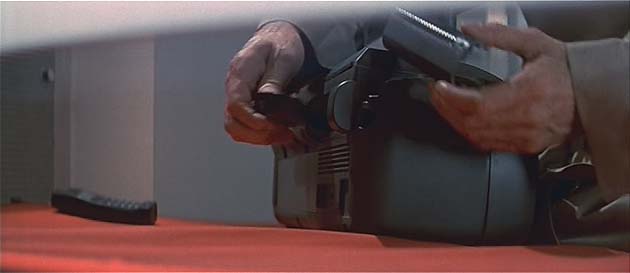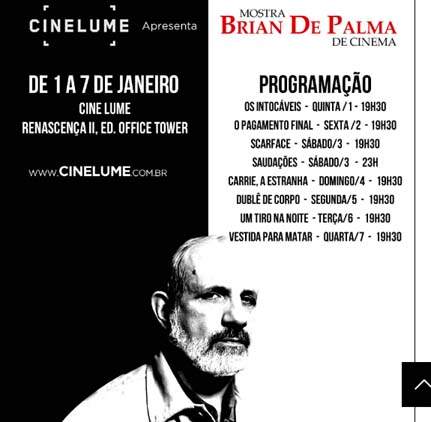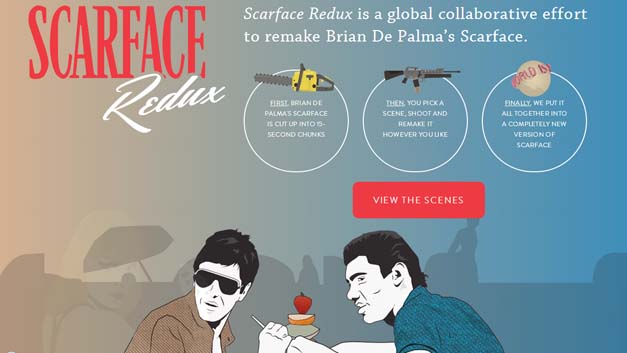TWO VIEWS ON THE 'MISSION: IMPOSSIBLE' FILMS
COMPARING/CONTRASTING THE FOUR FILMS, AND AN ALL-OUT DEFENSE OF WOO'S ENTRY Den of Geek's Tim George
Den of Geek's Tim George posted an article yesterday examining the unique ways in which each film in
Tom Cruise's
Mission: Impossible franchise has been "clearly delineated by the vision and preoccupations of its particular director." For the first film, George focuses on the ways in which
Brian De Palma utilizes suspense techniques learned from watching the films of
Alfred Hitchcock:
-----------------------------It is a testament to De Palma’s technique that Mission: Impossible’s most memorable sequence involves Tom Cruise hanging from a wire, and is not dependant on more traditional set pieces. The midnarrative set piece would become a tradition in the sequels, with De Palma’s successors putting their own spin on an IMF mission. The most important aspect of Hitchcock’s style that De Palma has made his own is his use of an omniscient point-of-view. De Palma’s camera may appear to approximate the subjective view of the characters, but his directorial control dictates what the viewer can see. An early example of this is the early sequence where Ethan Hunt witnesses his boss’s death by an unseen assailant via a camera in his glasses. All that Hunt (and by extension, the viewer) can see is a hand firing a gun directly at the camera. Later, when this scene is revealed to be staged, De Palma shows the action from a long shot to reveal what is really going on.
De Palma’s focus on suspense allows for other homages to Hitchcock, which are more decorative. Following his showdown with the villains, Ethan Hunt watches helplessly as a helicopter’s rotor blade spins toward him. This bit of action is reminiscent of a key moment from the climax of Strangers On A Train, where a technician sneaks under an out-of-control ferris wheel to switch off the mechanism, while the ride spins at high speed only a few inches above his head.
The introduction of the villain in the third act resembles the extended shot which identifies the twitching eyes of the killer in Hitchcock’s Young And Innocent. Starting from a long shot of a train, the camera pulls into a close-up of the killer’s hands through a window. This sequence also shows the influence of the Italian giallo, in De Palma’s use of mise-en-scene to conceal the villain’s identity. De Palma frames the character through a train compartment window, with his identity concealed by a half-closed blind. By framing the shot in this way, De Palma emphasises the character’s black gloves (a motif familiar from both the giallo genre and De Palma’s own Dressed To Kill) as he assembles a gun from the parts of a boombox.
De Palma is famous for his use of split screen to convey and build tension, and he integrates this technique into the opening action with a rather ingenious and subtle variation of the trope. As Jim Phelps (Jon Voight) directs his team, he watches their progress via cameras on their glasses. The respective point of views of these characters appear as a series of windows on his computer screen. In this way, De Palma renders his use of split screen as part of the mise-en-scene.
Sequences like this exemplify the degree to which De Palma is able to blend his style with the conventions of the genre he is working in.
-------------------------George is not impressed by
John Woo's follow-up to De Palma's film. "Indeed, aside from Newton’s role," states George, "everything in Woo’s film appears to be a pale re-hash of its predecessor, with the focus on action lacking the melodramatic heft of Woo’s best work.
Mission: Impossible’s most memorable set piece - Hunt being lowered by a wire - is re-worked as the prelude to an extended shoot-out. This sequence, intentionally or otherwise, exemplifies the divergence between De Palma and Woo when it comes to the material and their respective styles."
With JJ Abrams making his feature film directorial debut on the third film in the series, George notes "a shift in the franchise away from visual stylists to filmmakers with a background in screen writing." George appreciates that the third film brings a deeper emphasis on characterization than the second film had done. "Dramatically, Mission: Impossible III is far more substantial and enjoyable experience than its predecessor," states George. "However, there is no disguising a certain cynicism to the focus on character development. Some of these arcs work, but help make Mission: Impossible 3 feel like the season of a TV show collapsed into two-and-a-bit hours." For George, the most recent film in the franchise, Ghost Protocol, is a more comedic, physical, and ironic entry that positively reflects director Brad Bird's background in animated film. He also likes that Bird's film solidifies the team aspect of the franchise. "By the end of Ghost Protocol," writes George, "Brad Bird has delivered the first instalment since Brian De Palma’s original that manages to include all of the elements of the original concept while playing to the strengths of the filmmaker orchestrating the action."
AN IMPASSIONED DEFENSE OF JOHN WOO'S 'MISSION: IMPOSSIBLE 2'
Meanwhile, Entertainment Weekly columnist Darren Franich responded to a reader who asked, "In what universe is John Woo’s flaming mess of a Mission: Impossible 2 better than JJ Abrams’ totally and completely acceptable Mission: Impossible 3?"
Franich responded, "This is an important thing that we need to talk about. Because I have heard some variation of this argument constantly for going on nine years now. The conventional wisdom, in a nutshell: Mission 2 is an incoherent action film with a ludicrous plot and bad acting; Mission 3 is a solid Bourne-era shaky-cam spy movie with a good plot and a great villain. Some people even go so far as to say that Mission: Impossible 3 is their favorite of the franchise.
"Let’s throw out that chestnut right here. Ghost Protocol is the best Mission: Impossible movie. It’s arguably the least Tom Cruise-y of the bunch: By the fourth movie, Ethan Hunt is a semi-emotionless action-bot. But as directed by Brad Bird, Ghost Protocol is a film made out of one great setpiece after another. Bird has an animator’s gift for beautiful geometry: Cruise fighting his way down a corridor in the prison sequence, Cruise fighting his way through every level of a parking garage in the climax. But Ghost Protocol is also the only film in the franchise where the whole Mission squad matters; Cruise’s low-key performance leaves plenty of room for Simon Pegg as the comedy relief, Paula Patton as the badass, and Jeremy Renner as the Cruise-in-training.
"Nobody loves or hates the first Mission: Impossible, and nobody really talks about it anymore. Which is too bad. The first film deserves more credit for starting off with such a fakeout. You think you’re watching a movie about a squad of jocular superspies on a mission that requires cool makeup and subterfuge. And then by the half-hour mark, the whole squad’s dead. (They didn’t just kill Kristin Scott Thomas; they killed Emilio Estevez.) Director Brian De Palma always loved the first-act Psycho twist—see Sisters, see Dressed To Kill—and so the first Mission: Impossible has one of the great left-turns in any vanilla-blockbuster. As a bonus, Mission: Impossible turns one of the franchise’s most iconic characters into a bad guy—the kind of bold storytelling choice that franchises used to make before everyone got too scared of fanboy freakouts.
"Thus, Mission: Impossible 2. This is the movie where Tom Cruise has beautiful flowing long hair and climbs a mountain with his bare hands (just like Shatner in Final Frontier.) This is the movie where Tom Cruise falls in love with Thandie Newton, but then sends her undercover to spy on her ex-boyfriend, charisma vacuum Dougray Scott. This is the movie where the bad guy’s plot focuses on stock options, and the movie where Cruise defeats the bad guy by driving a motorcycle really fast.
"Or something: The plot doesn’t really matter, because the plot never really matters in Mission: Impossible movies, because honestly 'plot' is maybe the eighth most important part of a movie. (Things it’s behind, in no order: Characters, Casting, Dialogue, Cinematography, Music, Lighting, THEMES.)
"The Mission movies give good directors big budgets and let them explore their peculiar fascinations in the context of a boring spy thriller, and Mission is the last great gasp of John Woo in the John Woo Era: The period of time when the Hong Kong director was everyone’s favorite cult-action obsession. All of Woo’s movies are bonkers if you read the plot summaries, but Woo’s style is still sui generis even after everyone ripped off The Matrix ripping off John Woo. Woo is dude who loves dudes with guns, but he’s also a hopeless romantic who loves soft-focus shots of lovers in love, and he has a ludicrously precise aesthetic but he was making movies pre-digital so his precision isn’t antiseptic (like the Wachowskis.)
"So Mission 2 is ludicrous, and wonderfully so. Cruise and Newton flirt via car chase, and nothing isn’t in slow motion. There’s a central weirdness to the Cruise-Newton-Scott triangle: Scott is sort of an Evil Cruise, and sometimes he even puts on Cruise’s face, and there’s a weird sense that Scott and Cruise are both just using Newton as neutral territory where they can fight. (As played by Richard Roxburgh, Hugh is one of the great vaguely-homoerotic henchmen in action-movie history.) There are a couple of Meth Woo scenes, like when Cruise emerges from an explosion flanked by a dove because Catholicism. The final action sequence is a motorcycle chase that turns into a martial arts fight, except it’s 'martial arts' being fought by two identical-looking white dudes. Mission 2 was written by Robert Towne, and Towne basically just took Notorious and deleted half the dialogue." [A La Mod note: Woo has cited To Catch A Thief as his biggest inspiration for MI2.] "It’s not good but it’s completely unfiltered, and it’s a prime expression of Cruisedom at its peak: When Cruise dies eighty years from now, every obituary will mention Cruise climbing the Mission 2 mountain by the end of the second paragraph.
"Everything about Mission 3 makes more sense, and nothing about Mission 3 is remotely as fun. After a high-tension flashforward opening, the movie flashes back to an interminable first act. Cruise is getting married! To a boring nurse played boringly by Michelle Monaghan! Cruise has a boring squad—pre-Nikita Maggie Q looking great and pre-Tudors Jonathan Rhys Meyers looking angry—and they set off on a mission to rescue the only cool character in the movie, a pre-Americans Keri Russell. Russell dies immediately, but not before Abrams films a helicopter chase through a bunch of windmills that is one of the most incoherent action scenes not filmed by Michael Bay.
"This was Abrams’ first movie, and he hadn’t quite developed his style for the big screen. So there are a lot of visual choices in Mission 3 that feel TV-like in the worst way—close-ups and shaky cameras, the weird bluescale mid-00s monochrome that made every big-budget action movie looks like the Michael Douglas scenes from Traffic. The movie often suggests an episode of 24 with more explosions and zero moral ambiguity. The exception is the Vatican City scene, an excellent setpiece that also features the genuinely strange vision of Tom Cruise’s face being molded into Philip Seymour Hoffman’s face."
Franich concludes with his ranking of the films:
1. Mission: Impossible—Ghost Protocol
2. Mission: Impossible
3. Mission: Impossible 2
4. Joe Carnahan’s unfilmed Mission: Impossible 3, which would’ve co-starred Kenneth Branagh, post-Matrix Carrie-Anne Moss, pre-Match Point Scarlett Johansson, and would’ve apparently been the “punk-rock” version of Mission: Impossible. 5. JJ Abrams’ filmed Mission: Impossible 3, a.k.a. pop-punk version of Mission: Impossible.
 The other day, I posted a belated entry about a Brian De Palma retrospective at Cine Lume in Brazil. That retrospective ended yesterday, but it turns out there has been a separate De Palma series going on at Sala Walter da Silveira. This one started January 2nd, and runs through January 14th-- that last day, there will be a screening of a surprise De Palma film. This series includes many of De Palma films, and sometimes pairs them up with a film that inspired De Palma: Rear Window and Body Double were screened back-to-back on January 5th; Battleship Potemkin and The Untouchables were back-to-back last night; and Fritz Lang's The Thousand Eyes of Dr. Mabuse and De Palma's Snake Eyes were back-to-back earlier tonight. Monday, January 12th, Dario Argento's Suspiria will follow a screening of the movie that introduced Jessica Harper, De Palma's Phantom Of The Paradise. Back on January 4th, both versions (Hawks' and De Palma's) of Scarface were screened back-to-back, and on Tuesday January 13th, De Palma's Scarface will screen again, this time following a screening of Jean Vigo's Zero For Conduct. I've never seen the latter, so if anyone knows how it may link to Scarface, please feel free to share. Which reminds me, all of these screenings are free.
The other day, I posted a belated entry about a Brian De Palma retrospective at Cine Lume in Brazil. That retrospective ended yesterday, but it turns out there has been a separate De Palma series going on at Sala Walter da Silveira. This one started January 2nd, and runs through January 14th-- that last day, there will be a screening of a surprise De Palma film. This series includes many of De Palma films, and sometimes pairs them up with a film that inspired De Palma: Rear Window and Body Double were screened back-to-back on January 5th; Battleship Potemkin and The Untouchables were back-to-back last night; and Fritz Lang's The Thousand Eyes of Dr. Mabuse and De Palma's Snake Eyes were back-to-back earlier tonight. Monday, January 12th, Dario Argento's Suspiria will follow a screening of the movie that introduced Jessica Harper, De Palma's Phantom Of The Paradise. Back on January 4th, both versions (Hawks' and De Palma's) of Scarface were screened back-to-back, and on Tuesday January 13th, De Palma's Scarface will screen again, this time following a screening of Jean Vigo's Zero For Conduct. I've never seen the latter, so if anyone knows how it may link to Scarface, please feel free to share. Which reminds me, all of these screenings are free.





 I'm a little late with this, but
I'm a little late with this, but  Thanks to Peter for sending in this link to a
Thanks to Peter for sending in this link to a 


 "Taylor was always aware of what she was doing. She invited us to look at her so that she would not be watched. A Rolling Stone cover story interview revealed her obsession with surveillance and paranoia that her private world could be invaded through technology. It was a year when a number of female celebrities had their privacy invaded in a very violent way, and Swift was well aware she was a target. Her paranoid outlook in the Rolling Stone profile — that she might be snapped changing in a dressing room or bathroom by some untrustworthy soul — was justifiable. We all increasingly live in a surveillance state. But Swift lives in a Brian De Palma movie.
"Taylor was always aware of what she was doing. She invited us to look at her so that she would not be watched. A Rolling Stone cover story interview revealed her obsession with surveillance and paranoia that her private world could be invaded through technology. It was a year when a number of female celebrities had their privacy invaded in a very violent way, and Swift was well aware she was a target. Her paranoid outlook in the Rolling Stone profile — that she might be snapped changing in a dressing room or bathroom by some untrustworthy soul — was justifiable. We all increasingly live in a surveillance state. But Swift lives in a Brian De Palma movie.